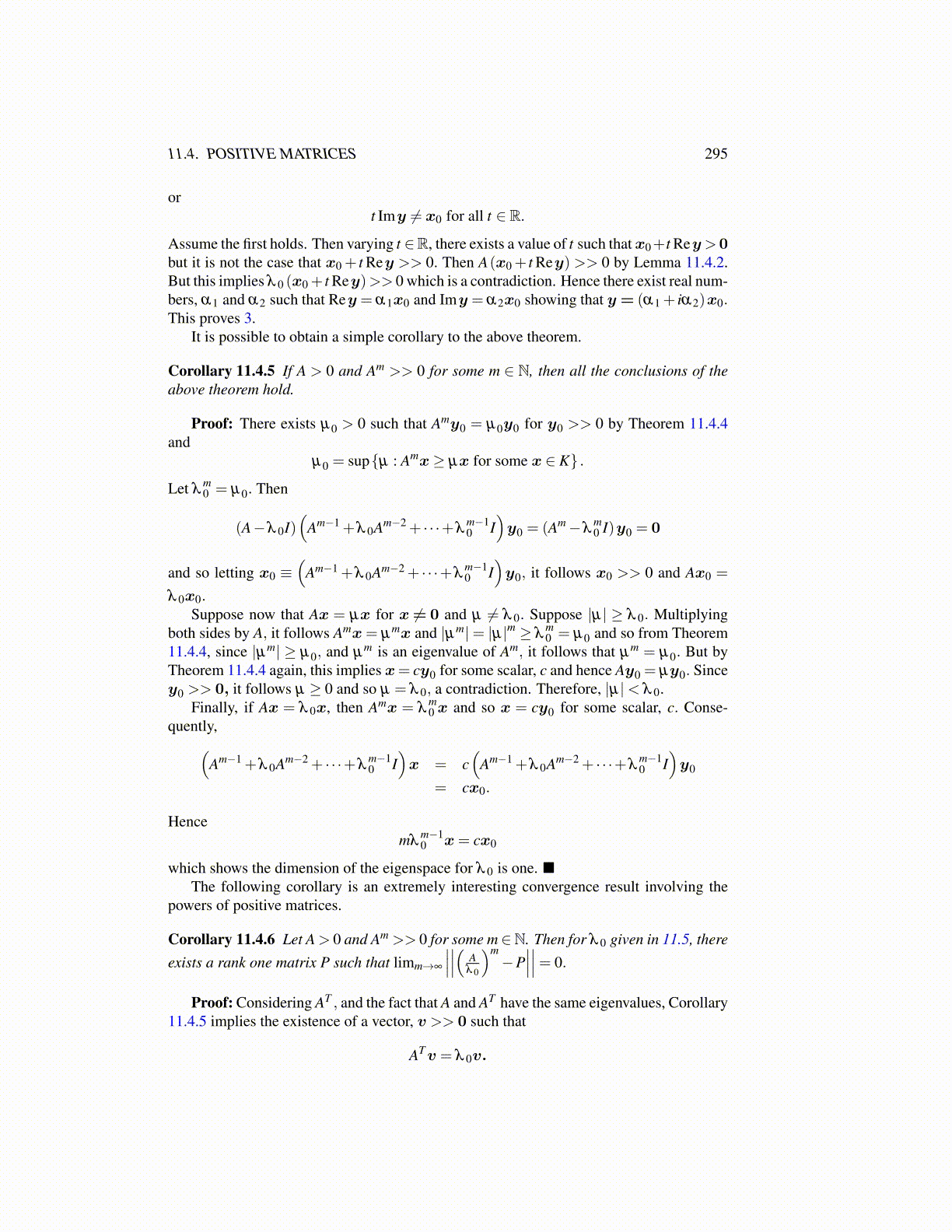
11.4. POSITIVE MATRICES 295
ort Imy ̸= x0 for all t ∈ R.
Assume the first holds. Then varying t ∈R, there exists a value of t such that x0+t Rey>0but it is not the case that x0 + t Rey >> 0. Then A(x0 + t Rey) >> 0 by Lemma 11.4.2.But this implies λ 0 (x0 + t Rey)>> 0 which is a contradiction. Hence there exist real num-bers, α1 and α2 such that Rey = α1x0 and Imy = α2x0 showing that y = (α1 + iα2)x0.This proves 3.
It is possible to obtain a simple corollary to the above theorem.
Corollary 11.4.5 If A > 0 and Am >> 0 for some m ∈ N, then all the conclusions of theabove theorem hold.
Proof: There exists µ0 > 0 such that Amy0 = µ0y0 for y0 >> 0 by Theorem 11.4.4and
µ0 = sup{µ : Amx≥ µx for some x ∈ K} .
Let λm0 = µ0. Then
(A−λ 0I)(
Am−1 +λ 0Am−2 + · · ·+λm−10 I
)y0 = (Am−λ
m0 I)y0 = 0
and so letting x0 ≡(
Am−1 +λ 0Am−2 + · · ·+λm−10 I
)y0, it follows x0 >> 0 and Ax0 =
λ 0x0.Suppose now that Ax = µx for x ̸= 0 and µ ̸= λ 0. Suppose |µ| ≥ λ 0. Multiplying
both sides by A, it follows Amx= µmx and |µm|= |µ|m ≥ λm0 = µ0 and so from Theorem
11.4.4, since |µm| ≥ µ0, and µm is an eigenvalue of Am, it follows that µm = µ0. But byTheorem 11.4.4 again, this implies x= cy0 for some scalar, c and hence Ay0 = µy0. Sincey0 >> 0, it follows µ ≥ 0 and so µ = λ 0, a contradiction. Therefore, |µ|< λ 0.
Finally, if Ax = λ 0x, then Amx = λm0 x and so x = cy0 for some scalar, c. Conse-
quently,(Am−1 +λ 0Am−2 + · · ·+λ
m−10 I
)x = c
(Am−1 +λ 0Am−2 + · · ·+λ
m−10 I
)y0
= cx0.
Hencemλ
m−10 x= cx0
which shows the dimension of the eigenspace for λ 0 is one. ■The following corollary is an extremely interesting convergence result involving the
powers of positive matrices.
Corollary 11.4.6 Let A > 0 and Am >> 0 for some m∈N. Then for λ 0 given in 11.5, thereexists a rank one matrix P such that limm→∞
∣∣∣∣∣∣( Aλ 0
)m−P∣∣∣∣∣∣= 0.
Proof: Considering AT , and the fact that A and AT have the same eigenvalues, Corollary11.4.5 implies the existence of a vector, v >> 0 such that
ATv = λ 0v.